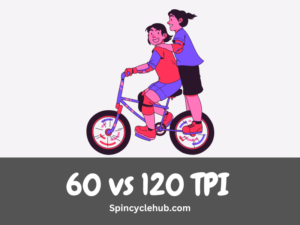Introduction
Have you ever found yourself staring at the sidewall of a tire, wondering what those numbers and letters mean? Well, you’re not alone. One of the most common mysteries in the world of tires is the TPI (Threads Per Inch) rating. In this article, we’ll dive into the debate between 60 TPI and 120 TPI and shed some light on which one might be the right choice for you. So buckle up and let’s roll!
Understanding TPI
Before we jump into the 60 vs. 120 TPI debate, let’s quickly understand what TPI actually means. TPI refers to the number of threads per inch in the tire casing. It indicates how many threads are woven into the tire per linear inch. Generally, the higher the TPI, the finer and more supple the tire’s casing will be.
The Case for 60 TPI
Durability Over Comfort
If you’re an avid mountain biker or frequently ride on rough terrains, a tire with 60 TPI might be the way to go. These tires typically have thicker, more robust casings, which offer excellent puncture resistance and durability. They can withstand harsh conditions without compromising performance. So if you’re a thrill-seeker who loves pushing the limits on rocky trails, a 60 TPI tire might be your best bet.
Cost-Effective Choice
Another advantage of 60 TPI tires is their affordability. Since they require fewer threads and less intricate weaving, they are generally cheaper compared to their higher TPI counterparts. If you’re on a budget or simply prefer a more cost-effective option, 60 TPI tires can save you some bucks without sacrificing too much in terms of performance.
The Case for 120 TPI
Enhanced Ride Quality
On the other hand, if you prioritize a smooth and comfortable ride, a tire with 120 TPI might be the perfect match for you. With a higher thread count, 120 TPI tires provide a more supple and flexible casing. This allows the tire to conform to the road surface, resulting in improved traction and a plush ride experience. If you enjoy long rides on paved roads or prioritize comfort over all else, 120 TPI tires could be the way to go.
Lightweight and Responsive
120 TPI tires are often lighter in weight compared to their 60 TPI counterparts. The increased thread count allows for thinner threads to be used, reducing the overall weight of the tire. This reduction in weight can result in improved acceleration and responsiveness. If you’re a speed demon or participate in races where every second counts, 120 TPI tires can give you that extra edge on the road.
Making the Choice: Which TPI is Right for You?
Now that we’ve explored the merits of both 60 TPI and 120 TPI tires, how do you decide which one is the right choice for you? Well, it all comes down to your personal preferences and riding style.
If you prioritize durability and cost-effectiveness, and often ride on rough terrains, a 60 TPI tire is likely the better option for you. These tires are built to withstand the toughest conditions and provide excellent puncture resistance.
On the other hand, if you value a comfortable ride and prioritize performance on smooth surfaces, a 120 TPI tire might be the ideal choice. The higher thread count offers improved flexibility and ride quality.

Conclusion
In the great debate of 60 TPI vs. 120 TPI, there’s no definitive winner. It all depends on your specific needs and riding preferences. So take a moment to consider what matters most to you – durability or comfort
, affordability or performance. Whichever TPI you choose, make sure to match it with the terrain you’ll be riding on and enjoy the smoothest and most thrilling biking experience possible.
FAQs
1. Can I mix tires with different TPI ratings on my bike?
Ideally, it’s best to avoid mixing tires with different TPI ratings. The varying characteristics of different TPI tires can affect the overall performance and ride quality of your bike.
2. Are higher TPI tires always better?
Not necessarily. Higher TPI tires offer improved ride quality and weight savings but come at a higher cost. It’s essential to consider your specific needs and riding style before deciding on a TPI rating.
3. Can I use 60 TPI tires for road biking?
While 60 TPI tires are generally more suitable for off-road or rough terrain riding, they can be used for road biking if you prioritize durability over performance and comfort.
4. Do TPI ratings affect tire longevity?
TPI ratings are more closely related to ride quality and performance than tire longevity. Proper maintenance, inflation, and regular inspections are key factors in extending the lifespan of your tires.
5. Can I convert a 60 TPI tire into a 120 TPI tire?
No, it is not possible to convert a tire from one TPI rating to another. The TPI rating is determined during the manufacturing process and cannot be changed afterwards.
Watch this one,
Video Credits – JustFrana
DOWNLOAD THIS ARTICLE : 60 vs 120 TPI
You May Also Like
-
Troubleshooting Guide: Why Isn’t Your Front Wheel Spinning Freely?
-
1984 Schwinn High Sierra: A Classic Ride That Stands the Test of Time



